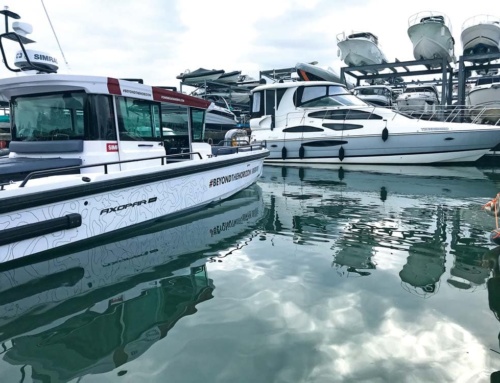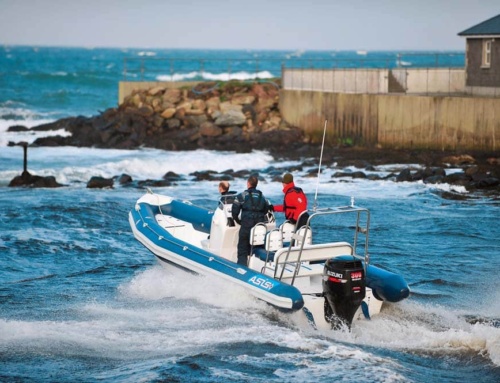Spend enough time on the water and it’s inevitable that you’ll either need a tow yourself or hear of someone else that needs some assistance. Paul Glatzel explains how to act safely and effectively …
Like anything we do afloat, knowing the techniques and rehearsing them makes it far easier to put the skills into practice when you need them. Towing is no different, but unlike some of the other things we do afloat, the presence of lines and cleats under continual or shock loading has the potential for injury if you don’t understand how to tow and what the ways to make it safe are. In this article we’ll look at when to tow, the various ways to set up a tow and how to set up tows to ensure they are safe.
With towing you are either going to be setting your own boat up to be towed or going to the assistance of someone else. Focusing initially on being towed, let’s look at some of the key points.
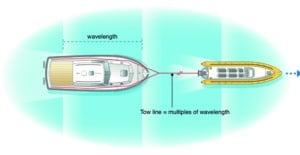
An inline or long tow set-up using a bridle and lines spreading the load to all of the cleats
If you’ve broken down it makes sense to contact the coastguard and ensure they are in the loop early on. The coastguard has no desire to task a lifeboat unless you really need it, so they will initially look for assistance from a commercial tow company (like Sea Start if they cover your area) or another boat. The benefit of the coastguard being involved early is that they have an overview and are looking at things objectively so are better placed than perhaps you are to see how to sort things. If you are broken down, have engine problems or perhaps a medical issue on board, then ideally get to a place of safety and anchor as it gives you one less thing to have to think about.
You will want to look at how the vessel that assists you is going to tow you and so where they will tie off to. There are two fundamental types of tow. When manoeuvring into a marina/berth, the tow will be an ‘alongside tow’ as this gives the greatest manoeuvrability. We’ll look at setting this up in a moment. Anywhere else up to that point and it will be an ‘inline’ or ‘long’ tow.
In a smaller sports boat up to about 28ft you will almost certainly have a D-ring under the bow, which is where, if you were trailing the boat, the winch strap of the trailer would be attached. That’s your strongest point. The issue with the D-ring is that it’s often inaccessible from the bow, so a well-set-up boat will rig a permanent line from the D-ring back to a cleat – often called a ‘painter line’. When the vessel comes in to tow you, get them to attach to this point if at all possible. If you can’t get to the D-ring or you don’t have one, you’ll need to tow from the cleats.
The issue with cleats is that they’re not really designed for the considerable shock loading they could be placed under when towing in rougher conditions, so you need to limit as best you can the load placed on each cleat.
To do this, rig a bridle from the two front cleats in a V shape. Run lines back to the cleats in the middle of the boat and then back to those at the stern. What you are trying to do is get lots of tension in these lines so that when the forward cleats experience shock loading, some of this load is transferred back to the other cleats. This can only happen if the lines are under lots of tension.
The final line will then be a long line from this bridle to a similar bridle at the stern of the towing craft.
When sorting a tow with another craft, look critically and ask whether they and their kit are up to it. A 14ft Fletcher with a ski rope is not the right set-up to tow your 2.5-tonne four-berth cruiser. Maybe they can be really useful, though, and stand by while you get assistance from a lifeboat or a larger craft. Equally, if the skipper in the Fletcher is well meaning but clearly clueless, you are risking danger to him and his crew, and you and yours, by letting him carry out the tow. You need to be prepared to say thanks, but no thanks.
With a long tow, ideally you want to use a longer line, as this reduces the effect of the shock loading since the towing and towed boats are often not in sync with each other on the waves. In an ideal world with perfect waves, you can set the line to a multiple of the distance between wave crests, but the waves are rarely this perfect, so you just use a long line and drive sensibly.
Like everything we do in a marina, do it slowly and accept you may not be able to perform a perfect alongside. Getting a line ashore then ‘springing’ in may be the best you can hope for.
There are a couple of tricks that can make some towing situations easier.
Knowing how to be towed is a basic skill to develop. Being able to set up tows and then tow other craft is a more advanced-level skill. Get out and practise before you need it for real!
Have fun and be safe!
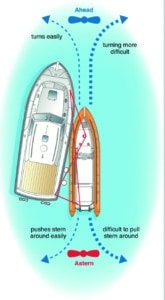 As you get to the marina you’ll want to be on a side tow. Doing a side tow can be great fun and really test your handling skills, so make sure you practise it before doing it for real. The image shows the set-up of the lines, and the fundamental principle is that you have a wide twin-engine craft with only one engine working. What this means in practice is that turning the bow towards the side where the disabled craft is should be easy as it will be pushing the stern that way, but trying to turn or push the other way may be impossible. This isn’t a great problem as long as you understand the principle and manoeuvre accordingly.
As you get to the marina you’ll want to be on a side tow. Doing a side tow can be great fun and really test your handling skills, so make sure you practise it before doing it for real. The image shows the set-up of the lines, and the fundamental principle is that you have a wide twin-engine craft with only one engine working. What this means in practice is that turning the bow towards the side where the disabled craft is should be easy as it will be pushing the stern that way, but trying to turn or push the other way may be impossible. This isn’t a great problem as long as you understand the principle and manoeuvre accordingly.
Note the way the of the RIB is angled in and its engine is behind that of the disabled craft.
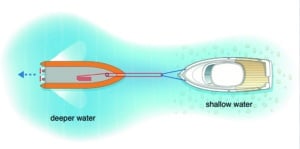
Bow-to-bow towing. In some situations there’s a need to get a boat under tow really quickly to stop it going aground or colliding with something. Or maybe the disabled craft is where you cannot get alongside safely to set up the tow. In this case, a line from your bow around the cleats, or ideally through the D-ring and then back to your craft, can give you the time you need to get into a safer position where you will have more time to set up a proper tow.
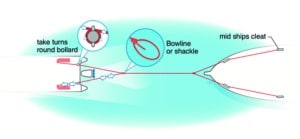
Varying the towline length when out at sea can be really beneficial as it lets you set the length to get a smoother tow. If you are tied off at the stern of the towing craft and the bow of the disabled craft, varying the length is impossible, but use the method shown in this image to allow you to ease out more line or shorten up the tow.

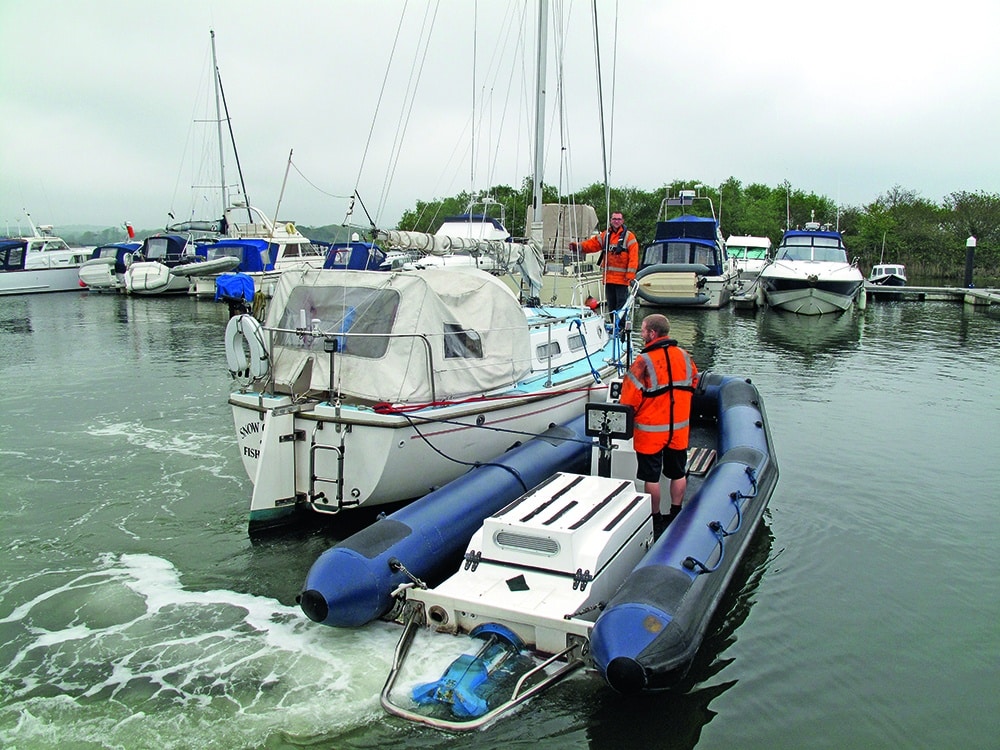
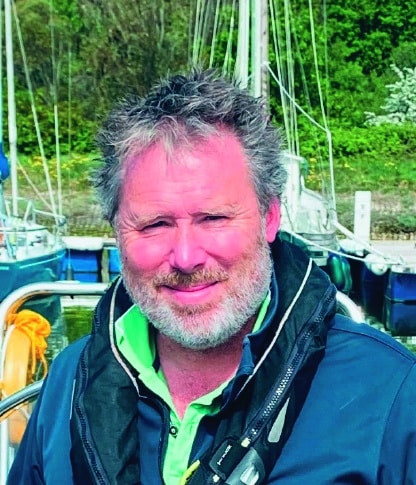 Paul Glatzel is an RYA powerboat trainer and wrote the RYA Powerboat Handbook and the RYA Advanced Powerboat Handbook. He runs Powerboat Training UK and Marine Education in Poole and Lymington (
Paul Glatzel is an RYA powerboat trainer and wrote the RYA Powerboat Handbook and the RYA Advanced Powerboat Handbook. He runs Powerboat Training UK and Marine Education in Poole and Lymington (